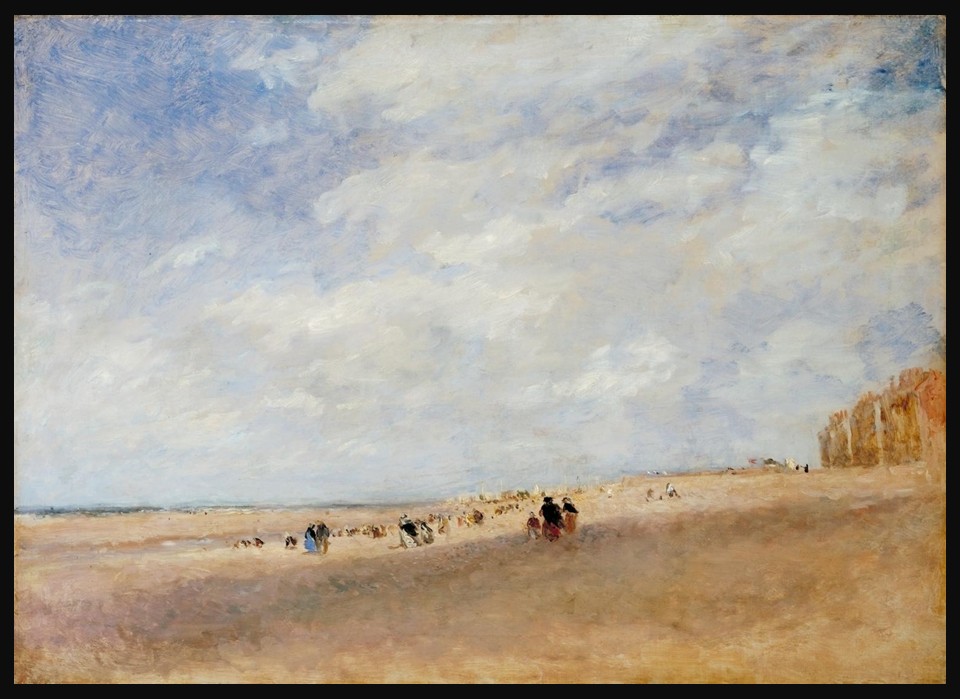
Rhyl Sands, c.1854, Oil on Canvas, 454 x 630 mm, the TATE, London, UK https://www.tate.org.uk/art/artworks/cox-rhyl-sands-t04130
Standing on the broad, breezy shore of Rhyl Sands, it’s easy to understand why David Cox was drawn to this stretch of the North Wales coast. In his painting Rhyl Sands, Cox captures not just the physical beauty of the beach—its golden expanse, the hazy sky, and the play of light on wet sand—but also the fleeting rhythms of seaside life. This was a place where families gathered, fishermen worked, and artists found endless inspiration. I’ve always found something quietly moving in Cox’s work; there’s a sense of peace in the wide-open space and an affection for the simple, everyday moments that unfold along the shore.
David Cox (1783–1859) was a prominent British landscape painter and one of the most important figures of the early English watercolour tradition. Born in Birmingham, he began his artistic career painting theatrical scenery before turning to landscape painting. Cox studied at the Royal Academy Schools and exhibited regularly at both the Royal Academy and the Society of Painters in Water Colours. He spent much of his career working between London and Birmingham, and later in life frequently visited North Wales, which became a major source of inspiration. His work played a key role in elevating watercolour painting to a respected art form in Britain.
Cox’s aesthetic is marked by a deep sensitivity to light, weather, and atmosphere. He is known for his expressive brushwork and ability to capture the fleeting moods of nature rather than its exact details. In his later years, his style became increasingly free and vigorous, often described as a forerunner to Impressionism in its focus on immediacy and movement. Rather than tightly controlled compositions, Cox preferred open scenes—windswept landscapes, coastal views, and everyday rural life—rendered with a bold yet subtle handling of colour and form. His work is celebrated for its emotional depth and naturalism, blending observation with a poetic interpretation of the landscape.
Rhyl Sands was painted by David Cox, a master of the British watercolour tradition, in 1854. By the time he created this painting, Cox was in his early seventies and had recently embraced oil painting following his training under W. J. Müller. He developed a particular attachment to North Wales, especially the coastal town of Rhyl, making multiple sketching trips there from the early 1840s. This version, one of three oil paintings on the subject, was acquired by Tate Britain in 1985 (Accession T04130) with help from the Friends of the Tate Gallery .
In Rhyl Sands, Cox opts for a painterly, weather-focused style, showcasing his mature technique in oils. The canvas, measuring 63 × 45.4 cm, is dominated by a sweeping sky of soft greys and whites that cast a delicate light over the sandy shore and its gently scattered figures. His brushwork is loose and expressive, blending sea, sand, and sky into an atmospheric whole rather than a detailed scene. Small human forms, beach carts, and distant buildings appear almost incidental, giving the composition a mood of open, unhurried space. The visual effect, achieved with muted tones and broad strokes, reflects Cox’s deep engagement with natural light and transient weather phenomena, qualities often seen as anticipating the Impressionist movement .
With its soft light, open composition, and subtle human presence, Rhyl Sands reflects Cox’s mature vision, rooted in observation but elevated by emotion and atmosphere. In blending the familiar rhythms of coastal life with an almost poetic treatment of light and space, the painting not only celebrates a specific landscape but also exemplifies the enduring power of landscape painting to evoke feeling, memory, and place.
For a PowerPoint Presentation of Rhyl Sands by David Cox, please… Check HERE!
Bibliography: https://www.tate.org.uk/art/artworks/cox-rhyl-sands-t04130